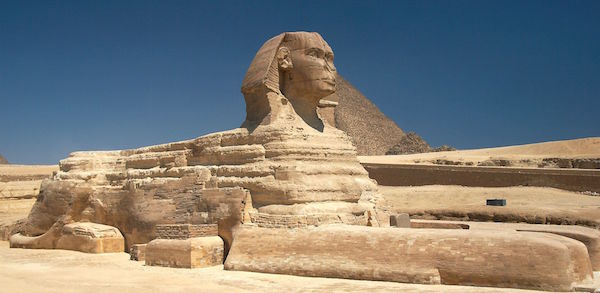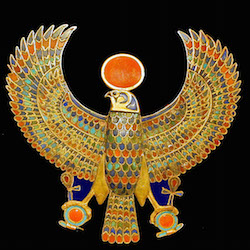As Horemakhet (Harmakhet, Harmachis) or “Horus in the horizon”, he represented the dawn and the early morning sun. He was often depicted as a sphinx with the head of a man, a lion, or a ram (the latter providing a link to the god Khepri, the rising sun).

It is often suggested that the Great Sphinx of Giza is a representation of Hor-em-akhet with the face of the fourth dynasty pharaoh Kafre (Chephren). He was also depicted as a falcon or as a man with the head of a falcon wearing a variety of crowns.
He was thought to be a source of wisdom as well as a representation of the sun. According to legend, prince Tuthmosis IV (Eighteenth Dynasty) was hunting in the marsh close to the Sphinx. He took a nap between its paws and dreamed Hor-em-akhet-Atum-Khepri was actually his father and that he was destined to be pharaoh. The god promised Tuthmosis the throne if he would remove the sand which was burying him. Tuthmosis agreed and was true to his word.

He became pharaoh and not only cleared the sand but promoted Ra-Hor-em akhet above Amon-Ra (heralding perhaps the rejection of Amun by Akhenaten in favour of the Aten, which was represented as a sun disc).
The pharaoh also dedicated a small temple to Hor-em-akhet on which the Sphinx was described as Hor-em-akhet-Hauron. It is thought that the Syrian and Palestinian workforce working near to the Sphinx associated it with their god of the underworld, Hauron. This link may explain the Sphinx’s epithet, “Father of Terror”.
- Horus; main page
- Heru-ur (Horus the elder)
- Khenty-Khem (foremost of Khem, Khenty-irty, Menkhenty-irty)
- Horus of Behedet (Horus of Edfu)
- Heru-sa-Aset (Horus the child of Isis)
- Horakhty (Horus of the two horizons)
Copyright J Hill 2010